Articles By Our Members
White LEDs from Christmas Lights
by Pat Suwalski, January 2009
At the end of the Christmas season, just about every hardware store sells
off its remaining Christmas lights at heavy discounts. They do not want to
store large supplies of stock for over ten months. The LEDs in Christmas
lights are completely regular LEDs and can be removed for use with lighting
models.
While the information in this article can be applied to any colour of
Christmas LED lights, quality white LEDs are the most difficult to obtain at
a decent price. Therefore, they are the most worthwhile to take the effort
of actually removing them from a solidly made chain of lights.
Background
Light Emitting Diode technology has progressed significantly in the last
decade. The picture below compares a typical 12V train model wheat bulb to a
typical "cool white" LED, the same painted with Tamiya Clear Orange to
soften the colour, an old "soft white" LED, and a modern "soft white" LED.
What is important is the colour at the center of each bulb and the colour of
the fading "halo" in the diffusing light.
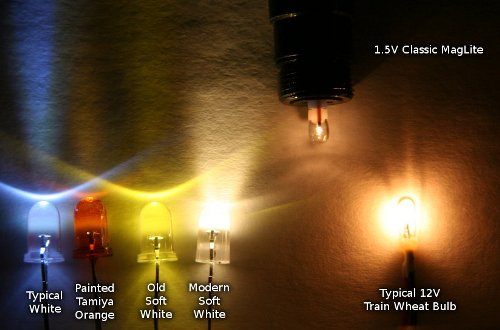
Clearly, the cool white LED produces very blue light. The painted LED
loses much of its brightness. The old soft white LED is far too yellow.
However, modern soft white LEDs have a very similar colour temperature to
the wheat bulb. The diffusing light does not have the dramatic orange hues,
but that is to be expected with the LED's limited light spectrum.
For all intents and purposes, the modern soft white LED is a practical
scale model representation of an incandescent bulb.
Small Light Strings
In 2007, a chain of 35 of these could be purchased for about $8 after the
holidays. They are somewhat tricky to crack open to extract the LED, but it
is definitely worth it, because 3mm soft white LEDs are actually difficult
to find otherwise. The Noma brand is shown here.
Simply cut around the already-scored line with a hobby knife. This will
remove the clear plastic diffuser and provide direct access to the LED
itself.
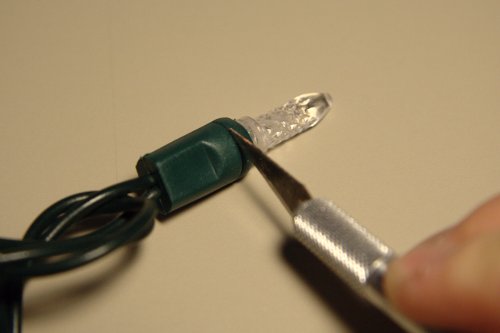
Next, with a hacksaw or rotary cutting tool, cut 5mm further down from
this scored line, where the flat taper begins. This cut should be all the
way through, to sever the LED completely from the string. Don't do this
with the string plugged in.
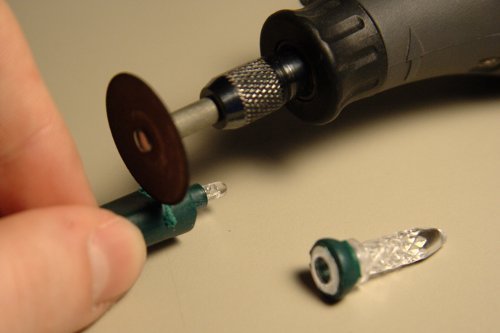
At this point the LED should be relatively easy to pluck from the plastic
collar with pliers.
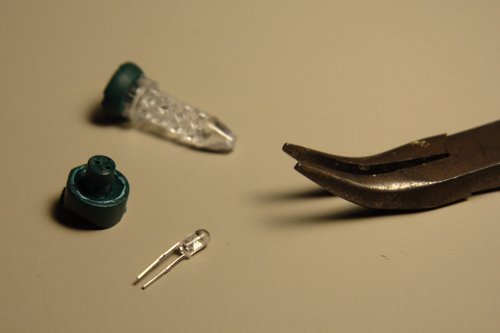
Bare LED Strings
The 2008 season seems to have brought around a new product from Noma,
which is a string of 5mm soft white LED lights, but without a plastic cover.
Additionally, these LEDs have the conical indent in the lens, which diffuses
light in many directions rather than at a tight angle.
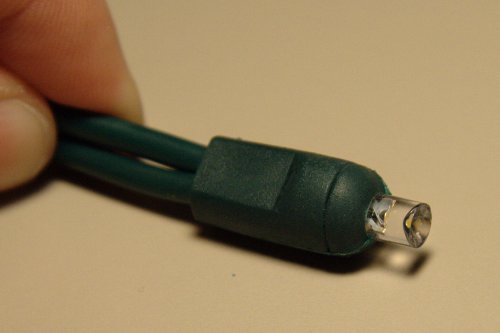
Logic would dictate that these lights would be even simpler to deal with
than the 3mm design above. Unfortunately, that is not the case. The LEDs are
soldered right up to the base of the lens, which makes it extremely
difficult to remove them. A combination of heat and rigorous cutting seems
the only way to get them out, and it takes a lot of work.
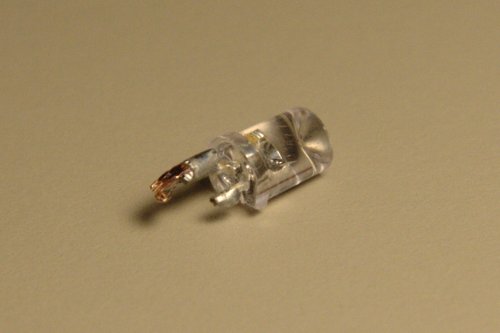
However, simply cutting off the entire encased unit is simple. In many
cases this solution is completely sufficient. At 15 dollars for a string of
100, these can definitely be useful.
Wiring
White LEDs are typically powered by 3.3V to 3.6V, at around 30mA. Running
at 3.5V seems to be a good target. Therefore, they should be wired in-line
with a resistor. Here is a table that can help:
| Battery Voltage | Ideal Resistor | Common Resistor |
|---|
| 5V | 57Ω | 47Ω |
| 6V | 90Ω | 100Ω |
| 12V | 283Ω | 220Ω+47Ω |
High voltages such as 12V may be more practical to wire in series. For
example, with a chain of three white LEDs in series, only a 47Ω resistor is
required. Two LEDs in series can be safely used with a 220Ω resistor.
Conclusion
The 3mm LEDs are definitely the best deal. They are difficult to purchase
individually, they are simple to remove from the string, and they probably
can be used in more scales than the larger 5mm components.
Pat Suwalski
|








